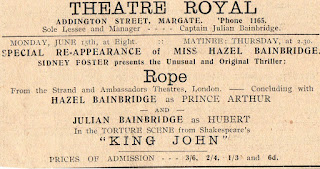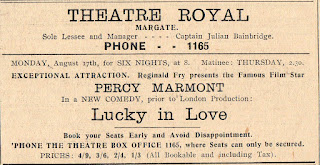It's sometimes strange how a chance purchase leads to a treasure hunt and an exciting new piece of the Theatre Royal jigsaw!! It all started when I recently purchased this advert from 1931...
Intrigued by the 'Hazel Bainbridge as Alice' line I googled her and discovered she came from a theatre family of several generations of actors and actor-managers. These included JW Boughton, her great-grandfather who built a theatre, ran a Shakespearean company, was a friend of Dickens and worked with Charles Kean. Her mother's parents acted and ran a theatre, her father Julian Bainbridge was an actor-manager and her mother acted in his company. That company ran the Theatre Royal Margate in 1931-2!!
Hazel Bainbridge was born on January 25, 1911 in Whitby, she acted in many of the productions at the Theatre Royal while her father ran the Theatre Royal!
She went on to become a 'jobbing' actress for most of her life in theatre and eventually TV appearing in many popular shows including 'Some Mothers do 'ave 'em, Emmerdale and most notably as a regular on Crossroads!!
Her husband, John Carroll, was a flying instructor for the RAF (Royal Air Force).
She was the ex-mother-in-law of Simon Williams, Richard Willis and Jeremy Young.
Grandmother of Tam Williams and Amy Williams.Hazel and John Carroll had two daughters, actresses Kate O'Mara and Belinda Carroll.
She died on the 7th of January 1998 aged 86
Then I managed to obtain a whole load more adverts (added further down) and articles from the same dealer filling in more of the Bainbridge era, here's a cutting with a picture of Hazel at the time.
All of this from an old advert!! A theatrical 'Dynasty' and more background on the Theatre Royal
'Only half a minute from the GPO!!!
Here is an extract from Malcolm Morley's 'Margate and it's Theatres' (THE book on the history of not only the TRM but all local Margate theatres. It's out of print, but if you see one buy it!! You won't be sorry!!) dealing with the early thirties...
No longer a storehouse for Messrs. Bobby and Co., the old
playhouse had been bought by Samuel Wenter, a furniture dealer with theatrical
ideas. Before the place could be put into use as a playhouse again, much was
required to be done, dusty and musty as it was after long years out of action.
The seating had to be restored, repairs were essential, likewise redecoration
inside and out. Everything was intended to bring a look of newness to the
Theatre Royal. The auditorium even had a new colour scheme of cream and gold
with mauve carpeting and seats. At last all was ready for a return to the fray
with its former rival, the Hippodrome.
The gala re-opening of the Theatre Royal, attended by the
Mayor and town celebrities, was on June 23rd, 1930, the play being Murder on
The Second Floor by Frank Vosper, who was soon to meet a tragic death.
Other road companies followed and later in the year energetic Guy Charles,
partnered by Charles B. Williams, ran a season of Repertory, A Little Bit of
Fluff to Facing the Music.
Repertory Company was now the term applied to a resident team of actors, rather like that of the former Stock Company. The main difference between Repertory and Stock was that in the first a play was discarded immediately after its run whilst in the second a number of plays were kept at the ready, as it were, and could be given at the shortest notice.
Following Guy Charles and partner, the Godwin Grand Opera Company occupied the house over the Christmas holidays and in the New Year Julian Bainbridge signed a three years lease taking the Theatre Royal from Wenter at a yearly rental of £750.
Repertory Company was now the term applied to a resident team of actors, rather like that of the former Stock Company. The main difference between Repertory and Stock was that in the first a play was discarded immediately after its run whilst in the second a number of plays were kept at the ready, as it were, and could be given at the shortest notice.
Following Guy Charles and partner, the Godwin Grand Opera Company occupied the house over the Christmas holidays and in the New Year Julian Bainbridge signed a three years lease taking the Theatre Royal from Wenter at a yearly rental of £750.
Bringing zest and experience to the task, Bainbridge
planned his campaign. He had been an independent manager at Whitby and had
toured his own companies. As an actor he had played with Lewis Waller and at
Sadler's Wells been a virile leading man through several seasons of drama. His
great aim was to restore the prestige of the Theatre Royal, no matter what was
doing at the parvenu Hippodrome. The new regime began on February 2nd, 1931,
with Carnival by H. M. C. Hardinge given by Anew McMaster and his Company.
An impressive player in classic mould, McMaster snapped his fingers at
metropolitan approval and spent most of his professional life, here, there, and
everywhere in his native Ireland. During his visit, extended to a month, he
gained local laurels as Othello and Hamlet.
A promising start had been made by the new management;
smooth sailing, but breakers were ahead. Bainbridge had hoped to book a
succession of the best companies on the road, only to find that most of the
best companies were leaving the road. The touring system was breaking down.
Films, now voicing themselves, were ousting the players and the Theatre Royal
and the Hippodrome were fighting each other for live entertainment. In May that
year the Hippodrome gave up and, calling itself a Super-Cinema, abandoned all
else for films, this time presumably for good. The Theatre Royal had won a
Pyrrhic victory.
 The slump of 1931 had severely affected the world of entertainment.
Playhouses were dying all over England, or else they remained comatose and
showed films, far less costly to run than plays. But Bainbridge struggled on,
making do with what companies he could obtain, generally having to give a
guarantee that their percentage of the receipts would reach a certain figure,
one which saved them from loss though it added to his own. To change this state
of affairs he arranged for Sidney Foster to give a series of productions for
which a nucleus of actors was retained. These included Norman Partridge and
Hazel Bainbridge, the manager's daughter, who had recently made her name in
The Patsy. The gamut was run from the verbal fireworks of The Last of
Mrs. Cheyney to the spine-freezing chills of Dracula. A return to
touring companies in the summer brought a winner in Smokey Cell by Edgar
Wallace whose crime-studded dramas had superseded the cardboard melodramas
apostrophizing heroes and deep-dyed villains of before the First World War. At
Christmas Alice in Wonderland was the bill, with Hazel Bainbridge a
delightful Alice.
The slump of 1931 had severely affected the world of entertainment.
Playhouses were dying all over England, or else they remained comatose and
showed films, far less costly to run than plays. But Bainbridge struggled on,
making do with what companies he could obtain, generally having to give a
guarantee that their percentage of the receipts would reach a certain figure,
one which saved them from loss though it added to his own. To change this state
of affairs he arranged for Sidney Foster to give a series of productions for
which a nucleus of actors was retained. These included Norman Partridge and
Hazel Bainbridge, the manager's daughter, who had recently made her name in
The Patsy. The gamut was run from the verbal fireworks of The Last of
Mrs. Cheyney to the spine-freezing chills of Dracula. A return to
touring companies in the summer brought a winner in Smokey Cell by Edgar
Wallace whose crime-studded dramas had superseded the cardboard melodramas
apostrophizing heroes and deep-dyed villains of before the First World War. At
Christmas Alice in Wonderland was the bill, with Hazel Bainbridge a
delightful Alice.
From January to July, 1932, the manager directed his own
Repertory Company in which he, his wife and his daughter all acted. But
whatever the play, be it The Lights of London, A Cuckoo in the Nest or
anything else, there was invariably a weekly deficit. In desperation poor Bainbridge
turned to twice-nightly Revue and Variety, with results worse than ever. The
nadir was reached in October when admission was 6d to all parts of the house
plus a penny to the Government as tax. An outside Repertory Company, named The
London Play Productions, held the stage for a few weeks, then a touring
pantomime Dick Whittington, a favourite subject in Margate, bowed the
old year out.
What course was to be pursued next? It was a burning
question. No satisfactory answer could be found and on January 16th, 1933,
following the example of the Hippodrome, the house surrendered to celluloid.
Films were exhibited at prices from 5d. to 1s. 6d. The theatre was now called
the Kinema Royal and, as such, carried on for eleven months to scant audiences.
Bainbridge could endure no more and fled the scene. In less than three years he
had lost altogether some £3,000.






















No comments:
Post a Comment